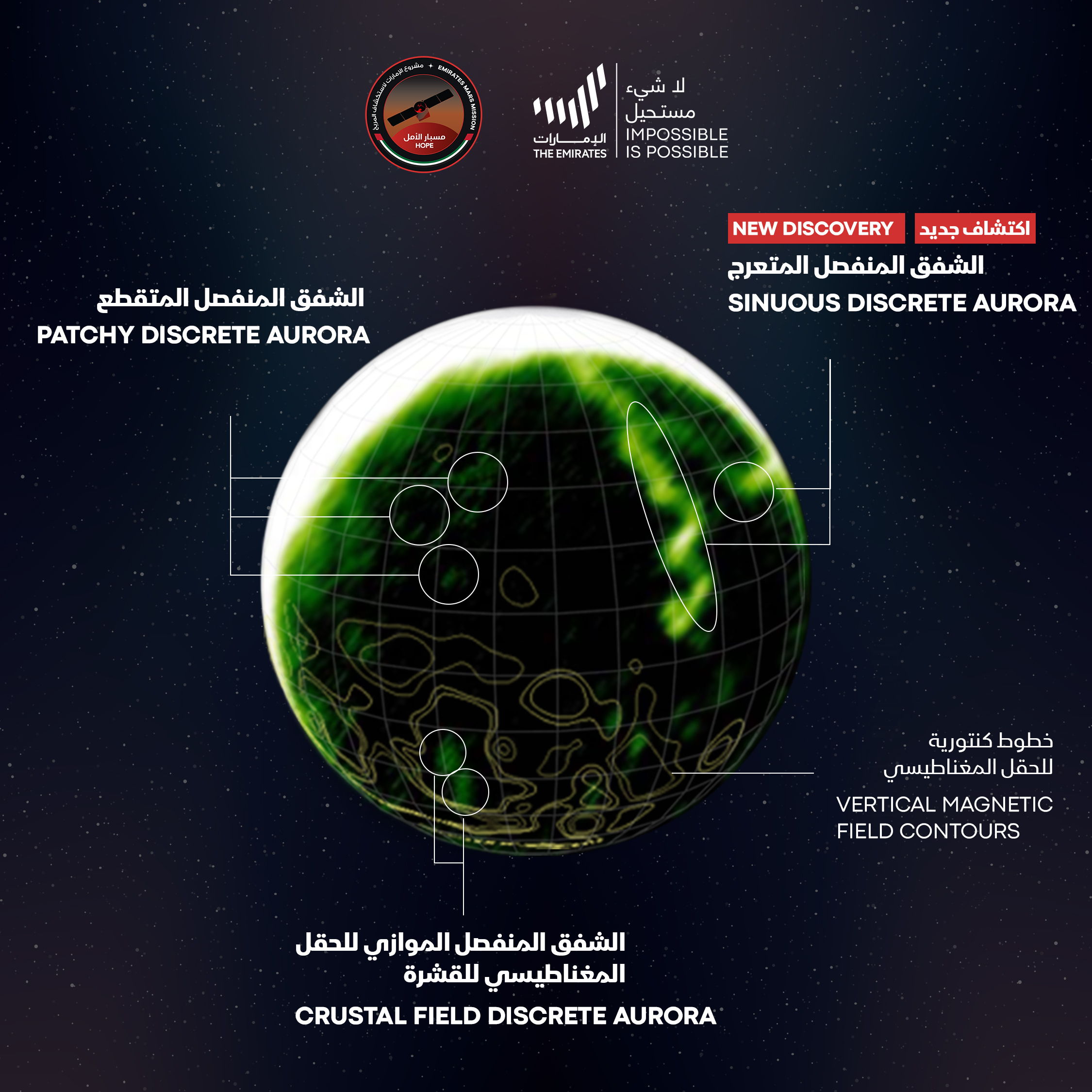Newfound auroras on Mars defy easy explanation
The 'worm-like aurora' spanned half of the Red Planet.

Scientists with the United Arab Emirates' Mars mission have spotted a 'worm-like' aurora stretching halfway across the Red Planet.
The discovery of "sinuous discrete" auroras, or shining lights high in the atmosphere arising from solar activity interacting with magnetic fields, came from observations from the Hope orbiter, which has been at work since February 2021. Mars has only a patchy magnetic field, making auroras tough to track down. Hope has already assisted with better observations of local, nighttime aurora varieties (diffuse aurora and discrete aurora) that eluded other missions.
But these other types of lights are nowhere near the scale of the new sinuous discrete auroras, which wrapped around half the planet. Observations at that scale required Hope's unique ability to take whole disk "snapshots" of the thin Martian atmosphere in action, officials said.
"We are seeing discrete auroral effects on a massive scale and in ways we never anticipated," Hessa Al Matroushi, EMM science lead, said in an emailed statement.
Related: The United Arab Emirates' Hope mission to Mars in photos

Previously studied types of Martian auroras are caused by a variety of factors. The discrete aurora, for example, apparently occurs above magnetic minerals in the planet's crust, while the proton aurora is caused by interactions between the solar wind, which is the constant stream of charged particles that flows off our sun, and hydrogen in the thin Martian atmosphere.
The newly identified sinuous discrete aurora is likely more similar origin to the diffuse aurora, which are caused by intense solar storms, according to the statement.
Get the Space.com Newsletter
Breaking space news, the latest updates on rocket launches, skywatching events and more!
Hope gathered its observations in ultraviolet light as a solar storm struck Mars. Conveniently, such solar storms will likely occur more frequently in the years leading up to 2025, when the sun's 11-year solar cycle is predicted to peak.
Scientists hope that better understanding the appearance of the sinuous discrete aurora and other auroral features could hone their understanding of the solar wind and the ways Martian magnetism affects the planet.
"Since those first observations of the discrete aurora, we have continued to see incredible new patterns of aurora that open new insights into the interactions of charged particles in the Martian atmosphere," Al Matroushi said. "There is a very great deal of new information here for the EMM [Emirates Mars Mission] science team to work with."
Detailed explanation is thin so far, however. That said, more information might be lurking in archival data from other missions, particularly that gathered by the long-running European Space Agency's Mars Express and NASA's MAVEN (Mars Atmosphere and Volatile Evolution) spacecraft that observe the Red Planet's atmosphere.
"The sinuous discrete aurora was a shocking discovery that in many ways has us scratching our heads and going back to the drawing board," Rob Lillis, a planetary scientist at the University of California, Berkeley who works on the Emirates Mars ultraviolet spectrometer instrument, said in the same statement.
"We have ideas, but no solid explanation for why we are observing intense aurora of this shape and at planetary scales."
Follow Elizabeth Howell on Twitter @howellspace. Follow us on Twitter @Spacedotcom or Facebook.
Join our Space Forums to keep talking space on the latest missions, night sky and more! And if you have a news tip, correction or comment, let us know at: community@space.com.

Elizabeth Howell (she/her), Ph.D., was a staff writer in the spaceflight channel between 2022 and 2024 specializing in Canadian space news. She was contributing writer for Space.com for 10 years from 2012 to 2024. Elizabeth's reporting includes multiple exclusives with the White House, leading world coverage about a lost-and-found space tomato on the International Space Station, witnessing five human spaceflight launches on two continents, flying parabolic, working inside a spacesuit, and participating in a simulated Mars mission. Her latest book, "Why Am I Taller?" (ECW Press, 2022) is co-written with astronaut Dave Williams.









